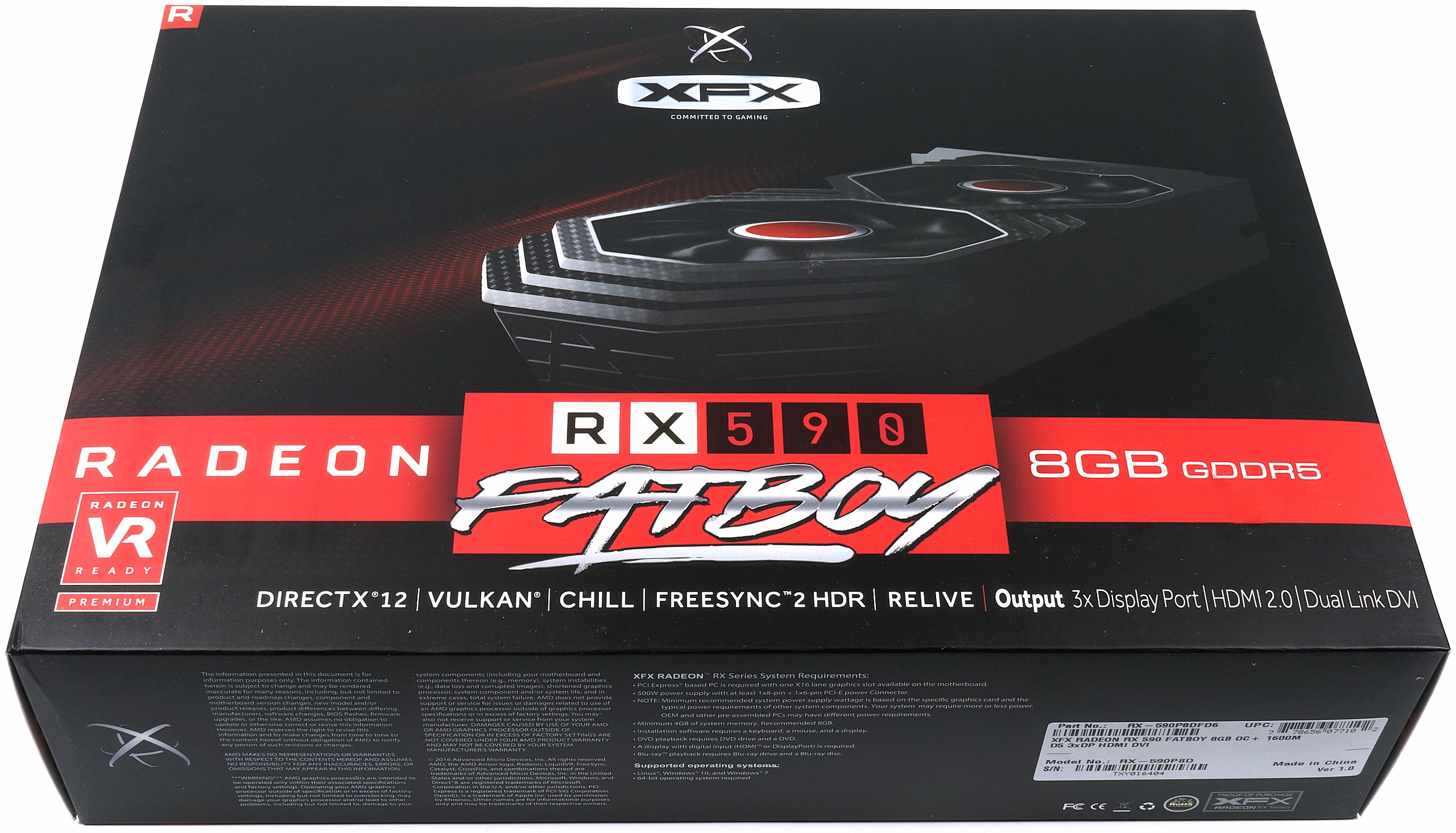Radeon RX 590 Review: AMD’s First 12nm GPU Hits 225W
Why you can trust Tom's Hardware
Conclusion
AMD launched its Radeon RX 480 as a 150W graphics card back in 2016. Pressure from Nvidia’s GeForce GTX 1060 just weeks later forced the company to repackage its Polaris GPU as Radeon RX 580, bumping power consumption up to 185W in the process.
More than a year later, motivated by the large price gap between Radeon RX 580 and Radeon RX Vega 56, AMD is re-repackaging Polaris as Radeon RX 590 to occupy some of that space. The company says it transitioned from GlobalFoundries’ 14nm FinFET manufacturing node to 12nm FinFET but won’t go into any more depth on the technology or its implications.
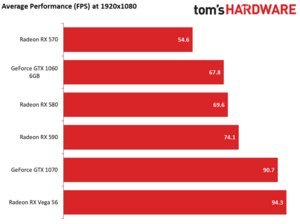
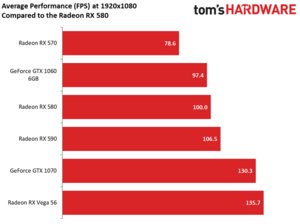
What we can see, however, are the benchmark results, power consumption measurements, value comparison, and efficiency calculation. Radeon RX 590 may benefit from a tuned process, but it’s still being flogged for a few percentage points of additional performance and sold at a higher price. It’s sucking down GeForce RTX 2080 power to generate frame rates between GeForce GTX 1060 and 1070. As a result, the Radeon RX 580 and 590 both look bad when we look at performance per watt.
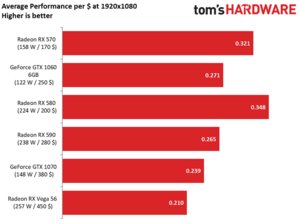
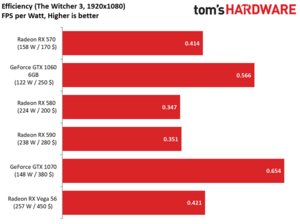
Sure, $280 (£250) for Radeon RX 590 remains a relative bargain to shell-shocked gamers still reeling from the cryptocurrency bonanza that saw mainstream graphics cards selling for two or three times their original worth. In that context, you’re basically getting a great (guaranteed) overclock at a 25 or 30 percent premium over Radeon RX 580 8GB. But we’d just as soon save some money and buy the cheaper Polaris card for high-detail gaming at 1920 x 1080. After all, RX 580s are readily available for less than the price point AMD launched them at back in 2017.
It would have been super cool to see some sort of die-harvested Vega 48 with 3072 Stream processors for somewhere in the $300 range. Unfortunately, AMD’s Vega GPU and its expensive HBM2-equipped package presumably make such a project implausible.
And so, we’re left with Radeon RX 590 instead. It’s faster than GeForce GTX 1060 6GB across our suite at 1920 x 1080 and 2560 x 1440, which seems to have been AMD’s goal. However, when we comb over graphics card prices and compare their performance, the real winner today is Radeon RX 580 8GB. Ample performance for cranking up quality at 1920 x 1080 and post-crypto-crazy pricing combine for some of the best deals we’ve seen on mainstream gaming hardware in 2018.
MORE: Best Graphics Cards
Get Tom's Hardware's best news and in-depth reviews, straight to your inbox.
MORE: Desktop GPU Performance Hierarchy Table
MORE: All Graphics Content
-
shrapnel_indie The further cut-down Vega sounds like it could have been a better option to me, primarily if they could make it work with GDDR5, GDDR5X, or GDDR6 memory.Reply -
elbert Wonder if we will see a RX 590X in a month or 2. Higher bin chips passing this overclock and with say GDDR5x 9GB memory.Reply -
v71 A conclusion & a possible editorial mistake:Reply
1. A used GTX 1070 for slightly over $200 is a better value today for 2k gaming.
2. It seems that in GTA V & Metro the slides were mislabled - the 1080p were placed under 2k and viceversa. Look at the presented framerates in those two games & you'll see that 1080p results are worse than 2k;) -
tslot05qsljgo9ed I hope you are joking because this RX 590 is the already the higher bin chips.Reply -
cangelini Reply21488265 said:A conclusion & a possible editorial mistake:
1. A used GTX 1070 for slightly over $200 is a better value today for 2k gaming.
2. It seems that in GTA V & Metro the slides were mislabled - the 1080p were placed under 2k and viceversa. Look at the presented framerates in those two games & you'll see that 1080p results are worse than 2k;)
Good eye! :)
The perf difference is actually from turning off SSAA at 2560x1440 in Metro and disabling 4xAA at 2560x1440 in GTAV as we try to keep QHD a playable resolution. Maintaining the same quality settings would have hit that res too hard. -
mohit9206 238W of power while gaming? That is unacceptable. 7nm cards can't come soon enough for AMD.Reply -
hannibal Reply21488220 said:The further cut-down Vega sounds like it could have been a better option to me, primarily if they could make it work with GDDR5, GDDR5X, or GDDR6 memory.
Yep, but that would require complete remaking that chip. Well Hopefully good Ryzen selling Numbers give money Also to gpu department so that They can afford to completely rehaul their low end and middle range cards. Even this 12nm with that 7.5 library would offer good gains if paineen with refress in architecture. But that remain to later timeframe. New card will require a couple of years, so if and because the company is in right track, one or two years From now there will be improvements if They start now the developmening it. -
mohit9206 Quote from anandtech reviewReply
"Once again though, we've observed that VRAM is never enough. It was only a few years ago that 8GB of VRAM was considered excessive, only useful for 4K. But especially with the popularity of HD texture packs, even 6GB of framebuffer could prove limiting at 1080p with graphically demanding games. In that respect, the RX 590's 8GB keeps it covered but also brings additional horsepower over the 8GB R9 390. For memoryhogging games like Shadow of War, Wolfenstein II, or now Far Cry 5 (with HD textures), the 8GBs go a long way. Even at 1080p, GTX 980/970 performance in Wolfenstein II tanks because of the lack of framebuffer. For those looking to upgrade from 2GB or 4GB cards, both the RX 580 and RX 590 should be of interest."
So as you can see 480/580 and 590 do benefit from the extra vram even at 1080p. I do feel all those people who asked on various forums on whether to buy 4gb or 8gb and got recommended 4gb since they were playing at 1080p were wronged as just a year or two later games are now benefitting from larger than 4gb framebuffer. Now those people will have to upgrade their cards sooner rather than if they had 8gb model they would have been able to keep the card longer.The forums can sometimes give wrong advice to people and screw them over. -
AgentLozen AMD got some awful diminishing returns from overclocking a 580. I wonder if we would see better returns if they reconfigured the cores and ROPs instead of using a 580 as the foundation.Reply
I'm disappointed with the 14nm -> 12nm transition. It seems like it did nothing to help with power consumption or heat. I was hopeful because it was helpful in regards to AMD's Ryzen chips.
